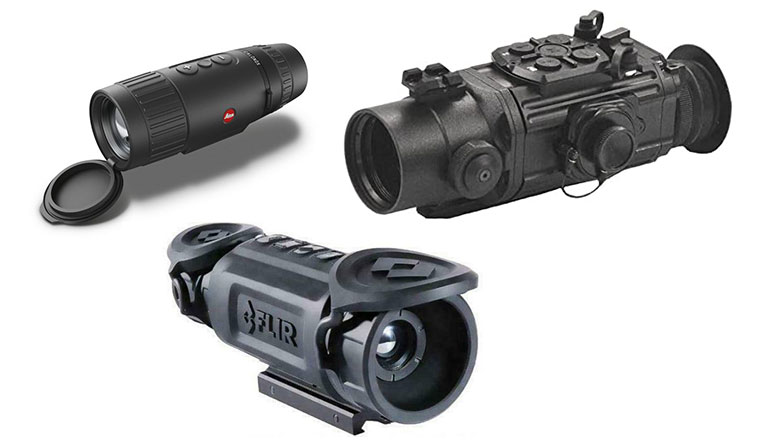Don’t know if infrared or thermal night vision is best for you, this is the piece you need to read. Consider this for a perfect, less-hassling choice!
Night vision sights and infrared technology make visibility in dark spaces worlds easier.
If you’re in need of night vision gear for hunting, tracking, and anything else, making a satisfying choice is crucial.
Taking charge of your surroundings for a better view is paramount for your security. And when you’ve got to get a successful hunt, the right gear is vital. But it’s not uncommon to see several buyers torn between an infrared and thermal imaging device.
If you’re currently in doubt when it comes to the best gear to select, here’s the deal-breaker you’ve always wanted!
With detailed facts on infrared night vision and thermal imagers, it becomes more natural to make a perfect pick. And it’s sure you’d know if you need both equipment right after this.
Contents [show]
Infrared vs Thermal Night Vision: Which night vision device is right for you?
Night Vision
I2, or image intensification, is tracking equipment ideal for night-time scoping. The image rendering from a night vision appears in green and gray hues.
Light capturing is the medium this equipment relies on for rendering images. It takes out light from dark environments and relays this light to a built-in tube. The light moves through this tube and enhances images around your environment.
Image intensification equipment relay images in green shades. The human eye captures green shades better than other hues. And with the green – grey images, trackers get an almost perfect view of a wide area.
Darkness impedes the quality of night vision equipment. Since night vision relies on ambient light, no matter how small, pitch darkness stunts its functionality.
Regardless, night vision equipment usually functions in very dark environments. In most cases, night vision could draw light from leaves, and structures around your hunting area.
Night vision gear currently comes in three generations. The generation you choose works with a different make-up and possesses varying degrees of efficiency. Check out the generations and how this equipment could add more to your tracking equipment;
Generation 1
An infrared illuminator features on all first generation night vision gear. The infrared illuminator is responsible for relaying images from the environment onto its front panel. Among the three generations, the first-gen illuminator has the lowest image clarity and precision.
Generation 2
A shorter field of view and enhanced image depth gets relayed from second-generation night vision gear. But in general, second-generation images are much brighter than generation one night vision equipment.
Generation 3
An enhanced field of view and easier adjustability features on third-generation night vision equipment. Third-generation images are much brighter than feeds from its two predecessors.
Infrared and Thermal Scopes
Thermal and infrared scopes are ideally similar when it comes to basic functions. Thermal imaging scopes perform a lot better, as long as you get your choices right.
Heat-reliant scopes function through gathering ambient heat instead of environmental light. The infrared energy drawn is essential to this scope’s operation.
Thermal scopes perform a lot better when it comes to extremely dark settings. Since these devices rely on heat instead of light, there’s better rendering potential, even during the day.
Infrared tech relays images with minimal heat like trees and buildings as dark pictures. On the flip side, living things and extremely hot objects get relayed in a bright hue through this scope.
All objects have a presence of heat, no matter how small, making infrared tech ideal for hunting in several settings.
Instead of relaying images in green and grey, thermal scopes render images in white, gray, and sometimes reddish-yellow.
A greater range is also sure on thermal scopes than night vision equipment. Night vision functions with surrounding light, limiting its operating range. But thermal images could capture objects over 200ft off.
If you’re using an extender with your thermal scope, it could magnify your possible range to four times better.
High-end thermal scopes could exceed 500ft easy and get a lot farther with magnification equipment.
Find here: Best ski goggles/snow goggles/ski helmet
Infrared vs Thermal Night Vision Head-to-head: which is better?
Although both gear have an excellent function to offer your hunting potential, there’s a marked functionality difference between them.
If you’re keen on getting an excellent field of view for game tracking, a thermal imager has the range you need. But when it comes to achieving clearer images on the move, night vision equipment is much better.
Some tips for keeping secure your night vision device
Beside the comparison of Infrared vs Thermal Night Vision, will discuss about some very essential tips for a night vision device. If your follow these below tips, you can keep your night vision device secure and as well as safe.
1. Always follow the Instruction Manual
From the first day of having a night vision device, must read the instruction manual before star using. Yes, sometimes it’s boring to read manual, but trust me, by reading you will be benefited.
2. Avoid Any and All Sources of Bright Light
This is one of the most important caution, don’t turn on your device and take out the protective lens cover during the daylight, even if you remove in front of lamplight, streetlights, large flames, or any bright light, which can lead to dangerous, unrecoverable damage.
3. Never take it apart because taking one apart is a big mistake.
4. Handle the objective Lens with sensitive care
5. Must have an sharp eye on voltage factor, use only recommended batteries.
6. Always remain careful in high humidity
7. As a NVD is not a toy, you must handle it with care. Avoid dropping, hitting, kicking or throwing of NVD.
8. Perform a maintenance schedule regularly
9. Be serious in Storage Procedures each time

I love all things tech, and I wear many hats – tech lover, business starter, digital marketer, and blogger. I know the ins and outs of Digital Marketing, SEO, SEM, SMM, and how to generate leads. My goal? Making things simple for you with clear guides and reviews. I stumbled upon WordPress while creating my first business site, and I fell in love with it right away. When I’m not building websites, creating content, or boosting clients’ online efforts, I’m focused on staying healthy, hanging out with family, and exploring the world. Connect with me on Facebook, Twitter, Linkedin, or read my complete biography.

